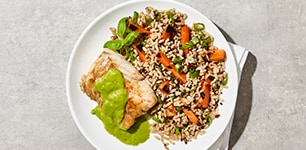Updated May 15, 2023
For those living with irritable bowel syndrome (IBS), a low FODMAP diet can be helpful. When done right, it may identify the foods that cause cramping, abdominal pain, bloating, gas, diarrhea, and/or constipation. You’ll have to stay on the diet only long enough to identify the foods that trigger your symptoms—generally two to six weeks.

What exactly is FODMAP?
FODMAP is an acronym representing carbohydrates that are difficult to digest or absorb. Fermentable describes the gases produced when gut bacteria ferments undigested carbohydrates. Oligosaccharides include two types of FODMAPs, fructans and galactooligosaccharides (GOS). Fructans are found across a variety of different food groups including onions and garlic, breads and cereals, and fruits and vegetables. Galactooligosaccharides are primarily found in beans.1
Disaccharides are made when two sugars are combined. An example is lactose, which is made up of the simple sugars glucose and galactose. Lactose is a common poorly absorbed sugar in some dairy foods. Monosaccharides, or simple sugars such as glucose and fructose, are commonly found in pears, honey, and agave syrup. Polyols are sweeteners usually added to sugar-free gum and mints. They’re also found naturally in pears, apples, cauliflower, mushrooms, and stone fruits. While it may sound scientific, it’s actually quite simple. Managing your intake of high FODMAP foods may help manage your IBS symptoms.2
How it works.
Some high FODMAP foods may trigger your IBS symptoms. Some may not. Follow these steps to find out which ones to avoid. Before starting, consult a dietitian or doctor.
Step 1: Go low. For two to six weeks, follow this chart to swap high FODMAP foods for low FODMAP foods.2
| Food group | High FODMAP foods | Low FODMAP alternatives |
|---|---|---|
| Vegetables | artichokes, asparagus, cauliflower, garlic, green peas, mushrooms, onions, sugar snap peas | eggplant, green beans, bok choy, green bell peppers, carrots, cucumbers, lettuce, potatoes, tomatoes, zucchini |
| Fruits | apples, apple juice, cherries, dried fruits, mangos, nectarines, peaches, pears, plums, watermelon | cantaloupe, kiwi, mandarin oranges, pineapple |
| Dairy & alternatives | cow's milk, evaporated milk, ice cream, soy milk (made from whole soybeans), sweetened condensed milk, yogurt | almond, coconut, rice, and hemp milks; 1 oz soy milk (made from soy protein); hard, aged, or ripened cheeses (Brie, Camembert, feta); lactose-free milk |
| Proteins | chickpeas, lentils, some marinated meats/poultry/seafood, some processed meats | eggs, firm tofu, plain cooked meats/poultry/seafood, tempeh |
| Breads, cereals & grains | wheat- and rye-based breads, breakfast cereals, pastas, grains, baked goods, and snack products | wheat/rye/barley-free breads; corn tortilla/taco shells; corn flakes, oats, quinoa flakes; quinoa/rice/corn pasta, quinoa, rice, polenta, rice cakes (plain) |
| Sugars & sweeteners | high fructose corn syrup, honey, sugar-free candy | maple syrup, table sugar, dark chocolate |
| Nuts & seeds | cashews, pistachios | macadamias, peanuts, pumpkin seeds/pepitas, walnuts |
Step 2: Reintroduce foods. Over the next eight to twelve weeks, reintroduce FODMAP-rich foods back into your diet. The goal is to find out which foods trigger symptoms and which do not. Start with a food rich in one FODMAP group, such as milk, daily for three days, and monitor your symptoms. You can also try foods that are high in two FODMAP types, such as apples, pears, or some beans and wheat products as well.
Step 3: Personalize it. After identifying your high FODMAP trigger foods, reintroduce well-tolerated foods back into your diet. It's all about finding the right balance. You may be able to reintroduce many high FODMAP foods into your diet, but you won’t be able to eat them as often or in the same quantity as before.3
FODMAP a path to success.
- Get started on the path to success by consulting with a registered dietitian (RDN). Since the diet is restrictive, a dietitian can help ensure that you are meeting your nutritional needs, particularly during the elimination phase of the diet. They can also ensure that you are following the diet correctly and not unknowingly including FODMAP foods in your diet. Also, once you begin reintroducing foods back into your diet, a dietitian can guide this process and help you customize your eating plan to assist with managing your symptoms.
- Find the most up-to-date information—and a helpful app—on high and low FODMAP foods at monashfodmap.com.* Science in this area is evolving, so be sure to check their site regularly for updates.
- Stock your pantry and refrigerator with the low FODMAP foods featured on the chart above.
- Keep your balance. This plan may be restrictive, but don’t oversimplify it and miss out on key nutrients for overall health. While foods such as white rice and chicken are low FODMAP, you need to eat more than these foods for a balanced diet. Be sure to include low FODMAP foods from each group (see chart). Try our Publix Aprons® recipe, Grilled Fish with Coconut-Ginger Sauce and Carrot-Rice Salad, for a Thai-inspired meal with seafood, whole grains, and vegetables.
- Plan ahead. You will most likely cook most of your meals at home to ensure that they are low FODMAP. Set aside a day to plan and cook meals. Divide them into containers for the fridge or freezer. Our Chocolate-Oatmeal Bake—served with raspberries—offers a warm, sweet, low FODMAP breakfast.
- Wait! No garlic and onions? Yes, it can be done. While they play a huge part in the way we cook, here are some substitutions that can take their place.
- Go green. The green parts of onions are low FODMAP—not the white parts. Chives, with their delicate flavor, can be used as a garnish or a finishing ingredient at the end of cooking. Finely minced chives can give eggs, potatoes, or soups a subtle onion and garlic flavor.
- Go herbal with parsley, thyme, cilantro, basil, and/or rosemary from our Produce department.
- Go spicy with cumin, crushed red pepper, oregano, and turmeric. Check seasoning blends to ensure they don’t contain garlic or onions.4
- Go for flavor. You can still get garlic flavor by infusing it with oil. Peel and cut garlic into big pieces, sauté in oil for 1 to 2 minutes, then discard garlic pieces. The fructans (oligosaccharides) in garlic that cause IBS symptoms are not fat soluble, so cooking it briefly can impart garlic flavor.4
*By clicking the link above, you will leave www.publix.com and enter the Monash University's website that they operate and control.
For the love of you.
Choosing how you eat is uniquely personal. It’s about your needs, your preferences, and your goals. As your wellness ally, we’re in your corner with fresh ideas, recipes, and wellness icons that make it easier to shift toward wiser food choices. It’s all about you, at your very best.
Sources
1 Collins, Lyndal, and Dakota Rhys-Jones. Fructans & FODMAP Reintroduction. Monash University. June 10, 2022.
2 FODMAPs and Irritable Bowel Syndrome. Monash University. Accessed May 11, 2023.
3 Starting the FODMAP Diet. Monash University. Accessed May 11, 2023.
4 Adding Flavour without Adding Symptoms. Monash University. March 19, 2015.

 You are about to leave publix.com and enter the Instacart site that they operate and control. Publix’s delivery and curbside pickup item prices are higher than item prices in physical store locations. Prices are based on data collected in store and are subject to delays and errors. Fees, tips & taxes may apply. Subject to terms & availability. Publix Liquors orders cannot be combined with grocery delivery. Drink Responsibly. Be 21. For prescription delivery, log in to your pharmacy account by using the Publix Pharmacy app or visiting
You are about to leave publix.com and enter the Instacart site that they operate and control. Publix’s delivery and curbside pickup item prices are higher than item prices in physical store locations. Prices are based on data collected in store and are subject to delays and errors. Fees, tips & taxes may apply. Subject to terms & availability. Publix Liquors orders cannot be combined with grocery delivery. Drink Responsibly. Be 21. For prescription delivery, log in to your pharmacy account by using the Publix Pharmacy app or visiting 
